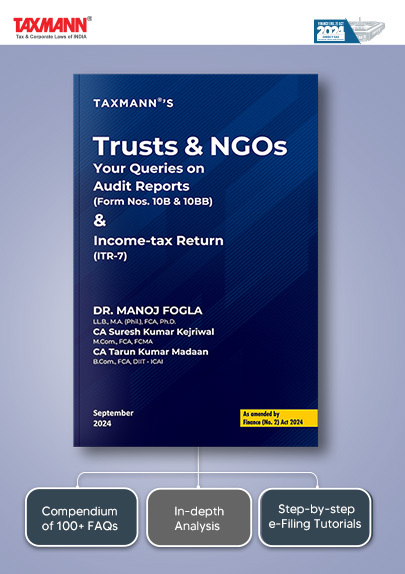CBDT Releases Order to Waive off Tax Demand Outstanding as of Jan 31, 2024; Capped at Rs. 1 Lakh per Assessee
- News|Blog|Income Tax|
- 2 Min Read
- By Taxmann
- |
- Last Updated on 21 February, 2024
Order, F.no. 375/02/2023, dated 13-02-2024
In the Union Budget 2024 speech, Finance Minister Nirmala Sitharaman announced the extinguishment of the tax demands until Assessment Year 2015-16. Subsequent to the speech, the Central Board of Direct Taxes (CBDT) has released an order to remit and extinguish the tax demands under the Income Tax Act, 1961, Wealth Tax Act, 1957 or Gift Tax Act, 1958 [“Acts”].
The order outlines various aspects of extinguishing the demands of different assessment years. It prescribes the monetary limit for outstanding tax demands and the maximum ceiling limit eligible for waiver for the assessee. The board has prescribed that demands which are outstanding as of Jan 31, 2024, shall be eligible for waiver. The following are the key takeaways from the order.
a) Monetary limit for waiver of demand
Until AY 2010-11, demands up to Rs. 25,000 per entry are eligible for the waiver, whereas from AY 2011-12 to AY 2015-16, the waiver applies to demands entry up to Rs. 10,000.
b) Maximum ceiling of Rs. 1 lakh
Remission and extinguishment of eligible demands are capped at Rs. 1,00,000 per assessee, regardless of the total eligible amount across assessment years.
c) No waiver for TDS/TCS demands
The CBDT specifies that waiver of demand doesn’t apply to the demands raised against the tax deductors or collectors under the TDS or TCS provisions of the Income Tax Act, 1961. Thus, the outstanding demand for eligible assessment years will be exclusive of the demands arising from TDS/TCS provisions.
d) Tax demand includes principal component of tax and any other interest
The outstanding demand comprises the tax principal under the Act plus interest, penalty, fees, cess, or surcharge as per Act provisions, with the ceiling limit as applicable.
e) Interest on account of delayed payment not to be considered
It’s clarified that interest under section 220(2) isn’t applicable for calculating the demand entry amount or the ceiling limit of Rs. 25,000, Rs. 10,000, or Rs. 1,00,000, respectively.
f) No right to claim credit or refund
It’s clarified that remission of outstanding demands doesn’t grant the assessee the right to claim credit or refund under the Income Tax Act or any other legislation.
g) No effect on criminal proceedings
Waiver of demand won’t impact ongoing or completed criminal proceedings against the assessee and doesn’t provide any benefit, concession, or immunity under such proceedings.
Click Here To Read The Full Notification
Disclaimer: The content/information published on the website is only for general information of the user and shall not be construed as legal advice. While the Taxmann has exercised reasonable efforts to ensure the veracity of information/content published, Taxmann shall be under no liability in any manner whatsoever for incorrect information, if any.

Taxmann Publications has a dedicated in-house Research & Editorial Team. This team consists of a team of Chartered Accountants, Company Secretaries, and Lawyers. This team works under the guidance and supervision of editor-in-chief Mr Rakesh Bhargava.
The Research and Editorial Team is responsible for developing reliable and accurate content for the readers. The team follows the six-sigma approach to achieve the benchmark of zero error in its publications and research platforms. The team ensures that the following publication guidelines are thoroughly followed while developing the content:
- The statutory material is obtained only from the authorized and reliable sources
- All the latest developments in the judicial and legislative fields are covered
- Prepare the analytical write-ups on current, controversial, and important issues to help the readers to understand the concept and its implications
- Every content published by Taxmann is complete, accurate and lucid
- All evidence-based statements are supported with proper reference to Section, Circular No., Notification No. or citations
- The golden rules of grammar, style and consistency are thoroughly followed
- Font and size that’s easy to read and remain consistent across all imprint and digital publications are applied





 CA | CS | CMA
CA | CS | CMA


